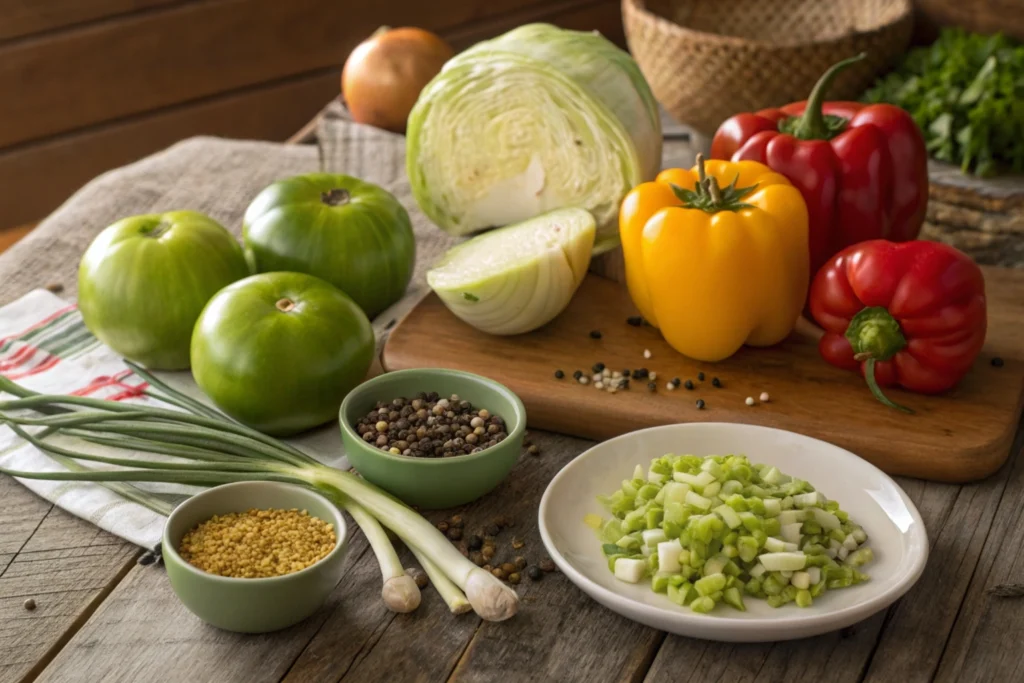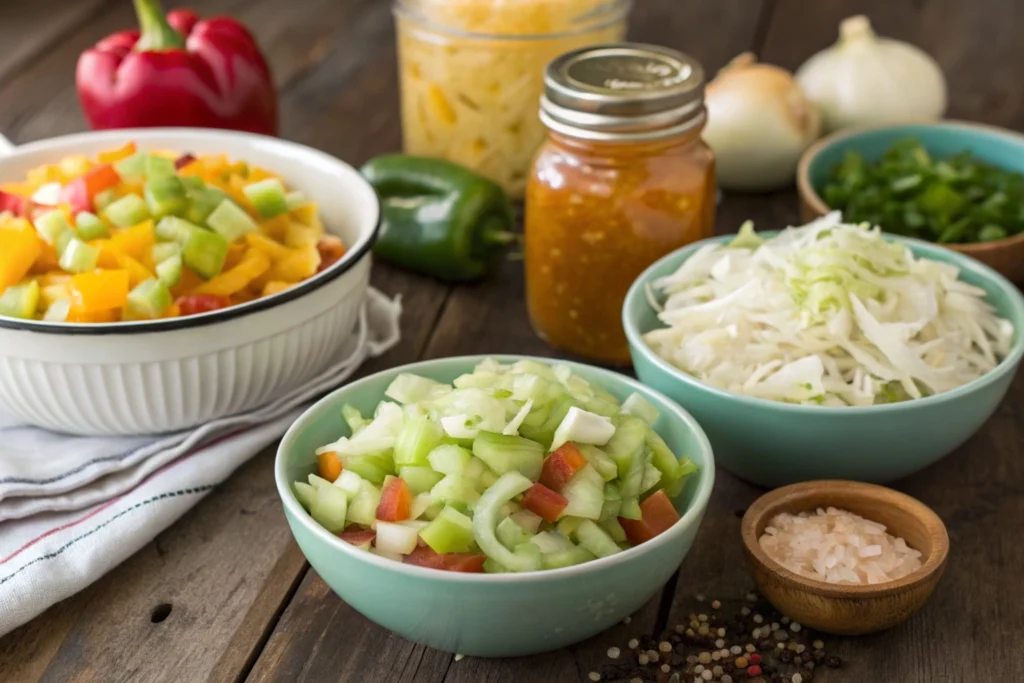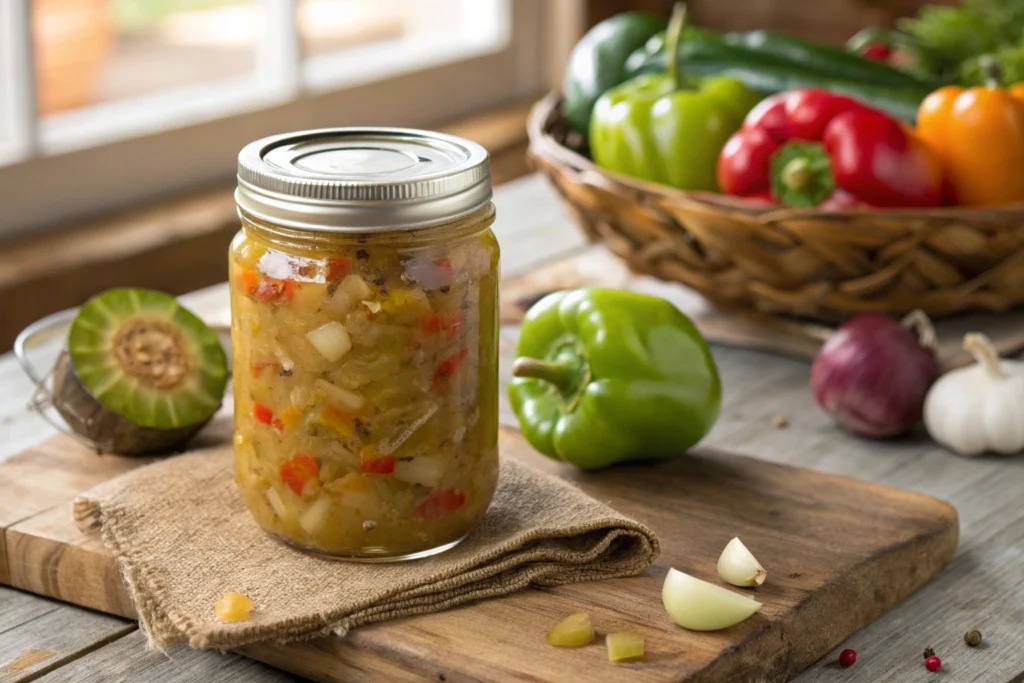Chow chow, a colorful and zesty relish, has been a beloved staple in kitchens across cultures for generations. Its tangy-sweet flavor profile and versatility make it a delightful addition to countless dishes. But what is chow chow made of, exactly? This article dives deep into the primary ingredients, regional twists, and cultural significance of this cherished condiment. Whether you’re a curious foodie or an avid home cook, you can explore how people prepare chow chow and discover what makes it so special.
Introduction to Chow Chow
Definition of Chow Chow
Chow chow is more than just a condiment—it’s a culinary tradition. Made from a medley of pickled vegetables, it serves as both a flavor enhancer and a cultural emblem. Southern and Northern American cuisines commonly feature this relish, with each region adding its own unique spin. At its core, chow chow blends sweet, tangy, and sometimes spicy flavors to elevate any meal.
The name “chow chow” might make you wonder about its origins. Interestingly, the name doesn’t refer to the fluffy chow chow dog but instead describes the mix of finely chopped vegetables. While the exact etymology remains unclear, some theories suggest it stems from the Chinese term “chou chou,” meaning a mix or a blend, reflecting its composition.
Historical Origins
The history of chow chow is as diverse as its ingredients. This beloved relish likely has roots in pickling traditions brought over by settlers and immigrants. Many attribute its rise in popularity to the American South, where resourceful cooks preserved surplus vegetables at the end of the growing season.
However, it’s not exclusive to the U.S.—chow chow also appears in Canadian and Caribbean cuisines. In each region, the blend adapts to local tastes and available produce, making it a reflection of its cultural context. The adaptability of this recipe has ensured its continued relevance in kitchens around the world.
Primary Ingredients of Chow Chow

Green Tomatoes
Green tomatoes are often the star of chow chow recipes. Their firm texture and slightly tart flavor provide the perfect base for this relish. Unlike their ripe red counterparts, green tomatoes hold up well during the pickling process, maintaining a satisfying crunch. They also balance the sweetness and tanginess of the brine, making them indispensable in many traditional recipes.
Cabbage
Cabbage adds a subtle earthiness and a crisp bite to chow chow. Finely shredded, it seamlessly blends with other vegetables, absorbing the tangy-sweet brine while contributing its own mild flavor. Recipes may call for green or red cabbage, each contributing its own unique color and texture to the mix.
Onions
No chow chow relish would be complete without onions. They bring a gentle sweetness that enhances the overall flavor profile. Many prefer yellow or sweet onions, but red onions can add a sharper, more robust taste to the mix. When pickled, onions soften slightly, adding a chewy yet tender texture to the relish.
Bell Peppers
Bell peppers, in shades of green, red, yellow, and orange, not only brighten up the jar but also add layers of flavor. They’re mildly sweet and slightly crisp, complementing the tartness of the brine. The choice of bell pepper color can influence the overall taste—red peppers tend to be sweeter, while green peppers add a touch of bitterness.
Vinegar and Sugar
Vinegar and sugar form the backbone of the relish brine. Typically, white distilled or apple cider vinegar provides the tangy kick and serves as a preservative, ensuring a long shelf life. To balance the acidity, sugar adds a touch of sweetness, creating the harmonious flavor that defines relish. Depending on the ratio of vinegar to sugar, the flavor can lean sweeter or tangier, catering to different preferences.
Spices and Seasonings
Spices and seasonings are where chow chow truly comes to life. Mustard seeds, celery seeds, turmeric, and sometimes a hint of chili powder or crushed red pepper flakes give the relish its signature punch. Each recipe has its unique spice blend, reflecting the cook’s preferences or regional influences. The spices not only enhance the flavor of the vegetables but also add vibrant color to the brine, especially with the addition of turmeric.
Regional Variations of Chow Chow
Southern United States Version
In the American South, chow chow is a pantry staple. Southern-style chow chow is often tangy with a hint of sweetness and includes green tomatoes, cabbage, onions, and bell peppers. It may also feature spicy elements like jalapeños or crushed red pepper flakes for those who prefer a bit of heat. Southern cooks traditionally serve chow chow with pinto beans, collard greens, or atop cornbread—turning simple dishes into culinary delights.
Northern United States Version
Northern chow chow recipes lean toward the sweeter side. These versions use sugar more generously and feature milder spice levels. Often, additional vegetables like carrots or green beans make an appearance, adding variety to the mix. Northerners commonly enjoy their chow chow alongside meats like roast pork or as a condiment for hot dogs and hamburgers.
Canadian Maritime Version
Chow chow in the Canadian Maritimes stands out for its use of green tomatoes as the primary ingredient. Unlike its American counterparts, the Canadian version is typically sweeter and less spiced, highlighting the natural tartness of the tomatoes. People often serve it with fish cakes or enjoy it as a side dish during festive occasions. This version reflects the region’s history of preserving seasonal vegetables for harsh winters, embodying the resourcefulness of Maritime cuisine.
Preparation Methods of Chow Chow

Traditional Preparation Steps of Chow Chow
Creating a traditional relish is a labor of love, with each step ensuring the flavors meld perfectly. The process begins with selecting fresh vegetables—cooks finely chop or shred green tomatoes, cabbage, onions, and bell peppers to form the base.
Next, cooks salt the vegetables and let them sit for several hours, sometimes overnight.This process draws out excess moisture, helping the relish achieve a crisp texture. Afterward, cooks rinse the vegetables thoroughly to remove the excess salt and then combine them with the brine—a tangy mix of vinegar, sugar, and spices.
Cooks gently simmer the mixture, allowing the vegetables to soften slightly while absorbing the vibrant flavors of the brine. Once cooked, they pack the relish into sterilized jars and seal them. This canning process allows cooks to store the relish for months, making it a practical way to preserve surplus produce.
Modern Adaptations
Modern twists on chow chow recipes cater to busy lifestyles and evolving palates. Today, many cooks skip the salting step, opting instead for pre-chopped vegetable mixes from grocery stores to save time. Some variations also feature non-traditional ingredients like zucchini, jalapeños, or even fruits such as green apples, adding unique flavors to the mix.
For those avoiding refined sugar, cooks can use alternatives like honey, agave syrup, or stevia in the brine to create a healthier version. Instant Pot or pressure cookers have also revolutionized chow chow preparation, significantly reducing cooking time while preserving the relish’s flavor and texture.
These adaptations prove that chow chow remains as versatile and relevant as ever, evolving with the times while retaining its beloved essence.
Culinary Uses of Chow Chow
As a Condiment
Relish shines brightest when used as a condiment. Its tangy-sweet profile complements a variety of dishes, from burgers and hot dogs to sandwiches and wraps. A dollop of relish can transform plain dishes like scrambled eggs or roasted vegetables, adding layers of flavor with minimal effort.
In Recipes
Incorporating relish into recipes elevates ordinary meals. Use it as a base for sauces, marinades, or even salad dressings. Some cooks mix relish into deviled egg fillings or use it to top nachos for a unique twist. It also pairs beautifully with grilled or roasted meats, providing a bright contrast to the richness of the protein.
Pairing Suggestions
Pairing relish with classic Southern dishes like pinto beans and cornbread is a time-honored tradition. For a modern touch, try serving it alongside smoked salmon, cream cheese, and crackers for an elegant appetizer. It also works wonderfully with cheeses—sharp cheddar and brie are particularly harmonious matches.
No matter how it’s used, relish’s versatility ensures it always has a place at the table, whether as the star or a supporting player.
Part 6: Nutritional Information
Caloric Content
Chow chow is generally low in calories, making it a guilt-free addition to your meals. A tablespoon typically contains around 10–20 calories, depending on the sugar content and specific ingredients. This makes it an excellent option for those looking to add flavor without significantly increasing calorie intake.
Vitamins and Minerals
Thanks to its vegetable base, chow chow relish provides a modest dose of vitamins and minerals. Green tomatoes, cabbage, and bell peppers contribute vitamins A, C, and K, as well as fiber. The inclusion of turmeric or mustard seeds in some recipes can also provide trace amounts of beneficial antioxidants, which support overall health.
Health Considerations
While relish is packed with veggies, the sugar and sodium content in some recipes might be a concern for people monitoring their intake. Opting for low-sugar or reduced-sodium versions can mitigate these issues, allowing you to enjoy relish more frequently. Plus, its probiotic benefits—if fermented—can support gut health, making it more than just a flavorful condiment..
Preservation and Storage
Canning Process
The canning process is the key to chow chow’s long shelf life. Sterilized jars are filled with the hot relish mixture, leaving a bit of headspace to allow for proper sealing. Afterward, the jars are submerged in boiling water for about 10–15 minutes, ensuring the contents are safely preserved. Once cooled, the jars are sealed tightly, ready for storage.
Shelf Life
When properly canned, relish can last for up to a year in a cool, dark place, such as a pantry or cupboard. However, once opened, it should be refrigerated and consumed within 4–6 weeks for the best flavor and quality. Always check for any signs of spoilage, such as discoloration or an unusual smell, before use.
Storage Tips
For optimal preservation, store unopened jars in a temperature-controlled environment away from direct sunlight. Once opened, ensure the jar is tightly sealed after each use to prevent contamination. If you’ve made a fresh batch without canning, keep it refrigerated and consume it within two weeks to enjoy its full flavor and crunch.
Cultural Significance
Chow Chow in Southern Cuisine
Relish is deeply embedded in the culinary heritage of the Southern United States. It’s more than just a condiment; it’s a symbol of resourcefulness and hospitality. In the South, this relish is often served alongside classic comfort foods like pinto beans, collard greens, and cornbread. Its tangy flavor provides a refreshing contrast to these hearty dishes, elevating them into something extraordinary.
Historically, relish was a practical way to preserve surplus vegetables at the end of the growing season. It became a beloved pantry staple, always ready to enhance meals or serve as a quick fix when unexpected guests arrived—an embodiment of Southern hospitality.
Family Traditions and Recipes
For many families, making relish is a cherished tradition passed down through generations. Recipes are often closely guarded secrets, with each family adding its own unique touch. Some might use extra spice for a kick, while others lean into sweetness, creating a relish that reflects their specific tastes and heritage.
Family gatherings and holidays often feature homemade relish, bringing people together over shared memories and flavors. This connection to the past and the act of preserving fresh ingredients contribute to the cultural importance of relish, especially in Southern communities.
Common Variations and Additions
Inclusion of Carrots, Beans, Cauliflower
Although traditional chow chow recipes focus on ingredients like green tomatoes, cabbage, and peppers, variations abound. Some cooks incorporate carrots for a hint of sweetness and vibrant color, while others add green beans or cauliflower for a heartier texture. These additions not only enhance the relish visually but also provide subtle flavor and texture differences, making each batch unique.
Sweet vs. Spicy Versions
One of the most noticeable variations in relish is the balance between sweetness and spice. Sweet versions, often found in the Northern U.S. and Canada, feature higher amounts of sugar and milder spices. They’re ideal for those who prefer a gentler, dessert-like tang in their relish.
Spicy relish, popular in the South, brings the heat with ingredients like jalapeños, chili powder, or red pepper flakes. This version is perfect for adding a bold kick to savory dishes and appeals to those who enjoy a bit of fire in their food. Both styles are widely loved and demonstrate the adaptability of relish to different tastes and cuisines.
Frequently Asked Questions (FAQs)
What vegetables are commonly used in chow chow?
Chow chow relish typically includes a mix of green tomatoes, cabbage, onions, and bell peppers as its main ingredients. Some variations also incorporate carrots, green beans, or cauliflower for added texture and flavor. The exact mix often depends on regional preferences and what vegetables are available locally or seasonally.
How long does homemade chow chow last?
When properly canned, homemade chow chow can last up to a year if stored in a cool, dark place. Once the jar is opened, it should be refrigerated and consumed within 4–6 weeks for the best quality. Always check for signs of spoilage, like an off smell or discoloration, before eating.
Can chow chow be made without sugar?
Yes, relish can be made without sugar, though the flavor will be less sweet and more tangy. Many modern recipes use sugar substitutes like honey or stevia to achieve a similar sweetness. Alternatively, you can skip sweeteners altogether for a sharper, more vinegar-forward condiment.
What dishes pair well with chow chow?
Relish is a versatile condiment that pairs beautifully with Southern classics like pinto beans, collard greens, and cornbread. It also enhances roasted meats, hot dogs, burgers, and even scrambled eggs. For a creative twist, use it as a topping for nachos, a filling for deviled eggs, or a side for fish cakes.
Is chow chow the same as piccalilli?
While similar, relish and piccalilli are not the same. Both are made with pickled vegetables, but piccalilli often includes a mustard-based brine, giving it a spicier, tangier flavor. Relish is usually sweeter and less intense, though recipes can vary widely.
How spicy is chow chow typically?
The spiciness of relish depends on the recipe. Traditional versions are mildly tangy and sweet, but some Southern recipes add chili powder, red pepper flakes, or jalapeños for extra heat. If you’re unsure about spice levels, look for mild or sweet varieties when buying, or adjust the spice in homemade recipes.
Conclusion
Summary of Key Points
Relish is a vibrant and versatile condiment made from a mix of pickled vegetables, such as green tomatoes, cabbage, and onions. Its rich history, rooted in Southern and global cuisines, highlights its adaptability and enduring popularity. From its traditional preparation methods to modern adaptations, relish remains a beloved accompaniment that complements a wide range of dishes.
Final Thoughts
Whether you prefer your relish sweet, spicy, or somewhere in between, there’s no denying its culinary charm. Its tangy, flavorful kick brings life to even the simplest meals. By exploring its ingredients, variations, and cultural significance, you can fully appreciate why relish has earned its place on tables around the world. Why not try making your own and adding a dash of tradition to your next meal?


1 thought on “What is Chow Chow Made Of? Discover Ingredients, Recipes, and Variations”